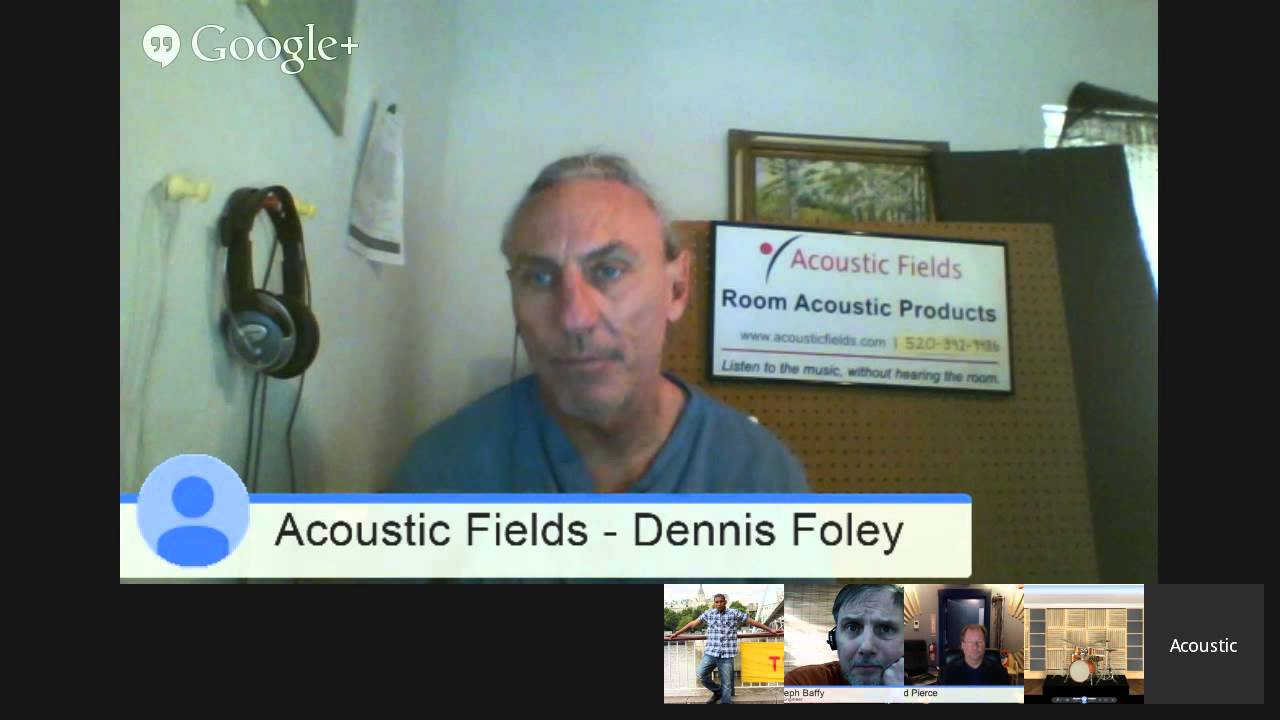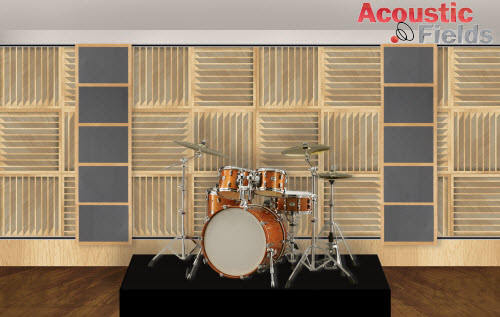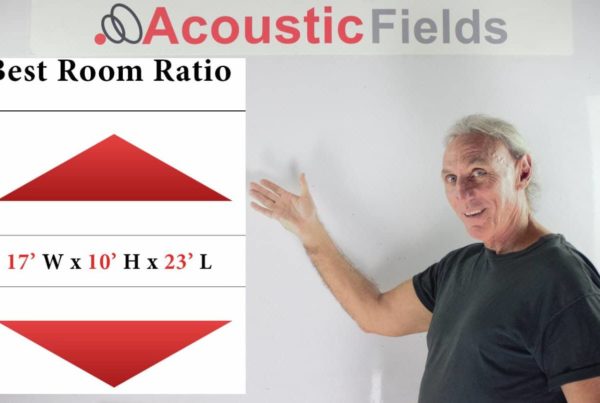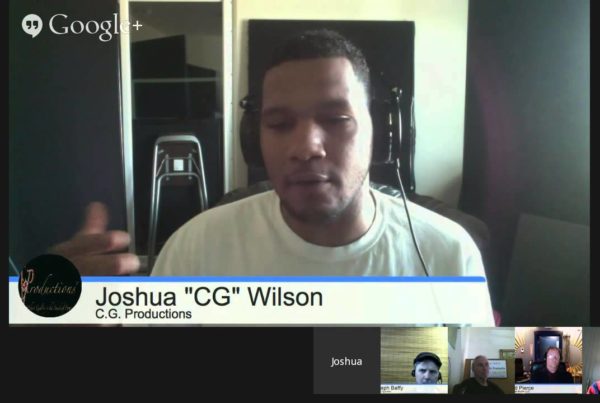In another of our monthly Google Hangouts with experienced and talented audio engineers Brad Pierce, Joseph Baffy and Joshua Wilson, we continued in our efforts to bridge the gap between what you are hearing as an engineer and how the room is causing that problem. The following video and transcript comes from one particular section where we addressed the issue “Why Recording Drums Is All About Managing Pressure & Reflections”. If you would like to see the full hour and a half discussion you can see the video further down the page.
Dennis: If you look at all this issues we’ve discussed when recording drums, they’re all pressure and reflection related. So if we stay in the those two domains and we really focus on those two areas, I think we’re going to do a lot to resolve the issues that you guys are fighting all the time. Minimize them so that we can let more of the music and the emotion come through. I’m not hearing instruments anymore in recordings. I hear something else, I’m not hearing real things.
I get that real estate’s expensive and people are mixing and mastering in smaller spaces and it’s a trend that’s continuing and the slopes that we’re headed upon are not good. To me, it’s always, when I listen to engineer’s talk all I ever hear is compromise. Everything is a compromise. Why do we have to compromise? Why can’t we have good source? Well, I’m not going to compromise and I don’t care what it costs me to get it right. I’m going to figure it out but I want you guys to have a good clean signal to work with and then you can screw it up on your own after that.
Joshua: But I think it’s all about what you’re looking for because like with me, I always wanted my recordings to be at industry level even when I started out young like at the age of fourteen. I knew what my sound was then at that level and I think because I had that kind of mentality. It’s like I’m just now working on my new album, I have all my stuff and right now the last thing I’ve realized is it’s the room acoustics that matter. Right now the microphones, gear and all that stuff I’ve learned like everything and like so, but at the end of the day I wanted something better than what I had.
So I think that’s the kind of the mentality you have to have to not compromise and I didn’t want to compromise with my sound quality so I kept getting better and better and better and better and now I’m at a point where I got to where I really wanted it to be. So now I can start making a product but it took me like 11 years to get here but it’s cool.
Joseph: It is cool and congratulations for sticking with it. There’s a lot of kids out there with the two-channel focus rates and the personas two channel. They’re just here for you know a week or year and that’s it. And it’s guys like you who are going to sustain the industry, who are sticking with it, who are working their way through.
I started, I’ll be going on my 11th year in March and you know as far as full time. You’re going to make a living out of this and it’s an incredible journey. It’s been an absolutely incredible journey. And I tell you, you said the secret, you gave Dennis the secret in your comments. You got your instruments, your gear, your microphones, your stuff, and now you’re working on your room acoustics. And that is going to be the story 99% of the time because it’s no fun to take your thousand bucks when you’re starting out and going to buy room acoustics and then sitting there and singing a cappella. You want to have a guitar and your bass and a computer first because that’s making music.
Joshua: The fun stuff.
Joseph: Yeah it is the fun stuff and so Dennis you’re going to face an uphill battle for a long time. It’s the professional that you’re going to be able to convert easily. The guys who’ve learned that, it doesn’t really matter if they have a $5,000 converter or a $1,000 converter, if they’re in the right space with the right talent, they’re going to get a really good record.
Dennis: Good sound, and I say this to all my customers every time they complain about the requirements I have for them, good sound in a room is a process where you do a lot of small things correct and in the right sequence and when I say sequence I mean you’re going to start with low end first and work your way up. So it’s a lot of little things, good quality sound is a lot of little things done correctly in the right order. And I believe we’ve missed a little bit of that process as we’ve move forward. We’ve sacrificed a little bit too much in that area so I guess I’m going to up back up a little bit.
The room is probably more important than your converters, your microphones or anything else. I proved that already here in my room. I have a 400 hundred dollar front end that brings people to tears. I don’t know any microphone or converter that can do that on its own so we have to step back a little bit. We have to step out of our processes a little bit and think on a macro level but react on a micro level and this is my attempt to get closer to the source.
Joseph: Well, I tell you guys what you did for me and after the last hangout that I was unable to attend, the discussion about your vocals and how Jason came to your place and recorded. One of my setbacks was a direct result of that. I decided to move the wall to my left here toward me 18 inches to give that to the booth that’s going to be on the other side. I’m not building a recording studio in my house, I’m building a mixing room with overdub capabilities or the ability to record a really good singer or a singer-songwriter.
So the space that I’ll be mixing in is now going to be 16×28 but the booth that we have is going to be 12 feet by 9 feet, approximately. There’s inches in there but I don’t know what those will be yet and the back, one of the walls of that booth, is going to have a reversible panel. That is going to have your foam which I’ll be purchasing within the next 7 to 10 days. I’ll be ready to actually install it. It’s going to have your acoustic foam and something similar to the way I built the diffusion, it’s similar to what you have on your photo there and just you know, you just pick it up and rotate it. Does that make sense? I wanted it to actually be able to turn on center access but I don’t have space. I don’t want to lose that extra foot and a half behind which that would require that wall to be able to spin.
Dennis: Yeah, well, it’s all about trying to figure out what the issues are, what the detriments are to good sound. Get those out of the way and really, if you look at this graphic here, the foam panels are like a knob on your workstation.
Joseph: Yes.
Dennis: And the room is just so important. I think we’ve lost a little bit of that as time moves on. I think the room has gotten kicked to the curb a little bit if you will. And it’s so important and it’s just so critical and I wish there was a better understanding of that in the recording process but there’s not.
It was funny the other day. Ali and I were, we were interviewing some business people for things we had to have done with the company and I could immediately tell they were sitting so far back from the microphone in a very large room because there were three of them on the call and the first thing I said to them was move forward towards the microphone and minimize room sound. So just you know just common sense things people don’t get, it’s kind of frustrating for me because I get it and it’s frustrating because sometimes I don’t have the language to communicate with people. I can only use examples and if people don’t experience the same thing you experienced in the example, you might not have good communication.
It’s tough, so our L.A facility is going to be all about changing the room acoustic dynamic in giving engineers more control over the things that drive them crazy and produce bad sounds and my room for the talent that is going to be there. You’re going to have to be good because you can’t sneak around in my rooms. You can’t cover things up in my rooms. I’m going to make you a better player. I’m going to make you a better singer. If you’re a better player and a better singer and the room is better, then we don’t have to use so much electronics. And that’s kind of the direction I’m headed.
So I think it’s going to be a fun project in a few months and I’m really looking forward to it. I’m actually to relocating to L.A to supervise it. It’ll be a good project all across the board. Anything, anybody else wants to add?
Joseph: I’m impressed. I’m really happy. I want to show you guys a picture before I leave though. Okay? Before we call it quits, alright?
Brad: Yeah, there it is.
Joseph: Yeah, you got it now. This product right here that I had mentioned that I have found and if you flip it over its black on the other side. In a pinch, and you need something that really does work, this is it. And this fondle of 8 pieces, 33.5 square feet, .53 inches thick, it really does wonders on a small room drum kit. That I know for sure. I mean it probably works in a big room as well but I know that in a small room it’s a fantastic decoupling. Okay? End.
Brad: Dennis do you have any foam products, a rubber products that you’re making for a 4-type application?
Dennis: No. I don’t personally create anything that is vibrationally oriented and this is all about vibration acoustics. Plenty of products in the marketplace that we can use that have the correct signature that you need for the amount of energy you’re dealing with and the R&D on products is very expensive. So it’s better to use existing products. Joseph points out a good one here. We have some other materials that we recommend that we use. There’s really good stuff out there. There are lots of companies that produce vibrational management tools because look, we all live with vibration everyday.
Joseph: In you manufacturing room, vibration is a humongous concern.
Dennis: Absolutely. From machinery and stuff like that. So yeah it’s the constant issue that’s been addressed for years and there’s good products. Now, that said those products have to match acoustically and work vibrationally. So they have double-edged task with us guys that are involved in sound. So, well, good, thank you everyone. It was great to talk. I think we’re trying to get the complicated simple as always. It’s not easy but if we keep pressure and reflections as our two variables in rooms, to try to make the complicated simple and address those two issues, I think we’re going to go a long way to get more quality in our recordings.
In Summary
To learn more about room acoustics and how drums interact with your room, please sign up to download our free ebooks and video series on room acoustics here. And please let me know if you have any questions at any time.
Thanks
Dennis Foley








